|

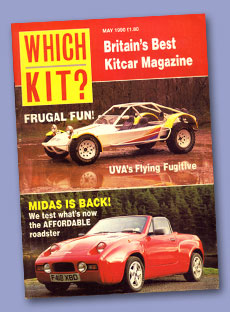 In
early 1990 Peter Filby visited the new Latham workshops
in Bicester. His article was as much a feature on Julia
Latham-Jackson as it was an article about the F2. Upbeat
and optimistic, it is hard to credit that the whole
venture had folded eighteen months later . . . In
early 1990 Peter Filby visited the new Latham workshops
in Bicester. His article was as much a feature on Julia
Latham-Jackson as it was an article about the F2. Upbeat
and optimistic, it is hard to credit that the whole
venture had folded eighteen months later . . .
Latham
F2 : The New Era
The
Latham F2 Super Sports seems to have been around for
a long time now without ever receiving the serious attention
it deserves — from either its maker or the public.
Any such indecision is now about to dramatically change
with the onset of a new era spearheaded by the determined
Julia Latham-Jackson. Peter Filby reports.
BBC
TV's Mastermind is a programme I always find memorable
not just for the incredible knowledge of most of its
contestants but also for its presenter's notably regular
delivery of the phrase "I've started so I'll finish."
For some reason, it's guaranteed to make me smile. Apply
it to Julia Latham-Jackson's current mood, though, and
it's deadly serious. Julia, you see, has been involved
with the smooth Latham F2 sportster for longer than
she cares to consider and right now she's strong on
determination that the car must gain the recognition
it deserves. Although several F2's have been delivered,
the car's gestation period has been too long. It's time,
feels Julia, that a truly original British sports car
in the MGB/TR6 mould was up there in the forefront of
the kit car industry — where it belongs.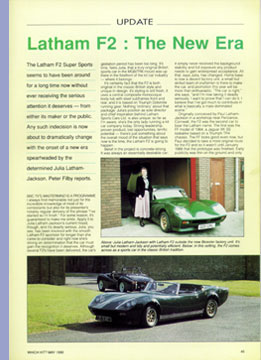
It's certainly fact that the F2 is both original in
the classic British style and unique in design: it's
styling is still fresh, it uses a central composite
monocoque body tub with steel subframes front and rear,
and it is based on Triumph Dolomite running gear. Nothing
'ordinary' about that package. Julia's position as sole
director and chief inspiration behind Latham Sports
Cars Ltd. is also unique: so far as I'm aware, she's
the only lady running a kit car company today. Strong
leadership, proven product, lost opportunities, terrific
potential — there's just something about the overall
mood of the situation that says now Is the time; the
Latham F2 is going to happen.
Belief in the project is concrete-strong. It was always
an essentially desirable car; it simply never received
the background stability and full exposure any product
needs to gain widespread acceptance. All that, says
Julia, has changed. Home base is now a decent factory
unit, a small but skilled team of craftsmen is there
to make the car, and promotion this year will be more
than enthusiastic. "The car is right," she
says, "and I'm now taking it deadly seriously.
I want to prove that I can do it. I believe that I've
got much to contribute in what is basically a male-dominated
scene."
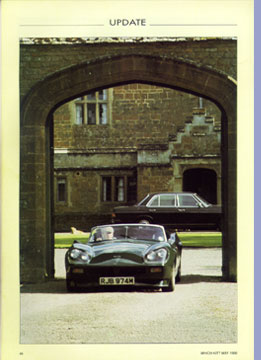 Originally
conceived by Paul Latham-Jackson in a workshop near
Penzance, Cornwall, the F2 was the second car to bear
the Latham name. The first was the FF model of 1984,
a Jaguar XK SS lookalike based on a Triumph TR4 chassis.
The FF looks good even now, but Paul decided to take
a more original route for the F2 and so it wasn't until
January 1988 that the prototype was finished. Early
publicity was thin on the ground and only one body/chassis
kit had been supplied before Paul moved base to a factory
near Oxford. Trouble was, only one further kit was supplied
before the F2 was allowed to fall dormant, although
not for long . . . Originally
conceived by Paul Latham-Jackson in a workshop near
Penzance, Cornwall, the F2 was the second car to bear
the Latham name. The first was the FF model of 1984,
a Jaguar XK SS lookalike based on a Triumph TR4 chassis.
The FF looks good even now, but Paul decided to take
a more original route for the F2 and so it wasn't until
January 1988 that the prototype was finished. Early
publicity was thin on the ground and only one body/chassis
kit had been supplied before Paul moved base to a factory
near Oxford. Trouble was, only one further kit was supplied
before the F2 was allowed to fall dormant, although
not for long . . .
Fired-up by the desire to engineer a satisfactory conclusion
to a project which had absorbed so much of Paul's ability
and knowledge, Julia took over the reigns in March last
year. "We'd lost a lot personally and financially,"
she recalls, "and I wanted to prove that Paul had
been right and the car was viable. I'd been heavily
involved right from the beginning and it became my personal
challenge."
Today, the Latham operation is at last established in
a 'proper' factory. Seven kits were turned out under
difficult conditions through 1989, but February this
year saw the long awaited move into a 2000 sq.ft. modern
unit in Bicester, near Oxford, home town of so many
racing teams and racing-associated companies. It's a
useful area to be in; there'll never be a shortage of
expertise and skilled car builders in Bicester.
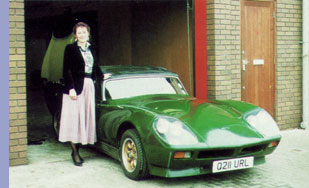 The
kit car that'll emerge from the new factory remains
as individualistic as ever. Styling is a totally subjective
area, but the F2's lines are unquestionably flowing
— from the faired-in headlamps to the squat, chopped-off
tail. Perhaps the real key to the car's visual appeal
is its pure styling originality. The
kit car that'll emerge from the new factory remains
as individualistic as ever. Styling is a totally subjective
area, but the F2's lines are unquestionably flowing
— from the faired-in headlamps to the squat, chopped-off
tail. Perhaps the real key to the car's visual appeal
is its pure styling originality.
From under that smooth skin come more surprises: the
structure draws influence from race car design with
a light yet extremely strong composite monocoque central
body tub. This unit's sills, floors and bulkheads are
of double-skinned sandwich construction and oodles of
plastic foam are injected into the box-sections to provide
extra torsional rigidity and considerable impact resistance.
Make no mistake, the whole assembly is quite a work
of art. It should have wide appeal, too, particularly
to those who care about efficiency and longevity.
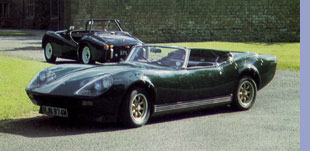 To
hold the suspension and drivetrain, the centre tub uses
tubular steel front and rear sub-structures. The double
wishbone front suspension is basically modified Dolomite
gear using special inboard damper units, steering is
rack and pinion, and the rear axle is live with appropriate
springing, all basically Dolomite sourced. Where parts
need modifying (as with the shortened propshaft), they
are available on an exchange basis from Latham Sports
Cars. To
hold the suspension and drivetrain, the centre tub uses
tubular steel front and rear sub-structures. The double
wishbone front suspension is basically modified Dolomite
gear using special inboard damper units, steering is
rack and pinion, and the rear axle is live with appropriate
springing, all basically Dolomite sourced. Where parts
need modifying (as with the shortened propshaft), they
are available on an exchange basis from Latham Sports
Cars.
The power unit is again of Dolomite origin, either in
1850cc form or the more powerful and sophisticated 2-litre,
16-valve Sprint version, the latter being capable, in
tuned form, of producing up to 200bhp. Since the F2
weights less than 14cwt, the pure entertainment factor
isn't difficult to imagine. And if that isn't enough,
the car enjoys more than average sporting practicality.
There's a decent sized cockpit, full heating and ventilation,
good weather protection, wind-up windows, plenty of
storage space behind the seats and a large, lockable
boot. A comfortable, long-distance tourer? Sounds like
it.
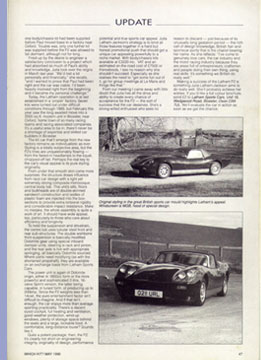 Quite
a potent package, then, the F2. It's clearly not short
on engineering integrity, originality of design, performance
potential and true sports car appeal. Julia Latham-Jackson's
strategy is to bind all those features together in a
hard but honest promotional push that should get a unique
car appealing powerfully to a niche market. With body/chassis
kits available at £3220 inc. VAT and an estimated
on-the-road cost of £7500 or thereabouts, I see
no reason why she shouldn't succeed. Especially as she
realises the need to "get some fun out of it, go
for group meetings at Le Mans and things like that." Quite
a potent package, then, the F2. It's clearly not short
on engineering integrity, originality of design, performance
potential and true sports car appeal. Julia Latham-Jackson's
strategy is to bind all those features together in a
hard but honest promotional push that should get a unique
car appealing powerfully to a niche market. With body/chassis
kits available at £3220 inc. VAT and an estimated
on-the-road cost of £7500 or thereabouts, I see
no reason why she shouldn't succeed. Especially as she
realises the need to "get some fun out of it, go
for group meetings at Le Mans and things like that."
From our meeting I came away with little doubt that
Julia has all the drive and ability to create every
chance of acceptance for the F2 — the sort of
success that the car deserves. She's a strong-willed
enthusiast who sees no reason to discard — just
because of its unusually long gestation period —
the rich cell of design knowledge, British flair and
sportscar purity that is the chariot bearing her name.
As she reflects: "I've come to genuinely love cars,
the car industry and the motor racing industry because
they are areas full of entrepreneurs, craftsmen and
people doing their own thing, using real skills. It's
something we British do really well."
Making
a success of the Latham F2 is something Julia Latham-Jackson
aims to do really well. She'll probably achieve her
wishes. We'll evaluate the car in action as soon as
we get the chance.
Photograph
captions: First image: Julia Latham-Jackson with Latham
F2 outside the new Bicester factory unit. It's small
but modern and tidy and potentially efficient. Second
image: In this setting, the F2 comes across as a sports
car in the classic British tradition. Black and White:
Original styling in the great British sports car mould
highlights Latham's appeal. Windscreen is MGB, hood
of special design.
With
thanks to Peter Philby
Which Kit? Magazine,
May 1990, pages 44-47
Which Kit? magazine is no longer published, having been
taken over and relaunched in May 2007 as Complete Kit
Car magazine. Click on the logo (right) to visit the
new website:
|